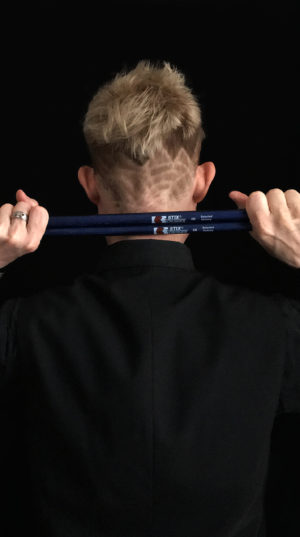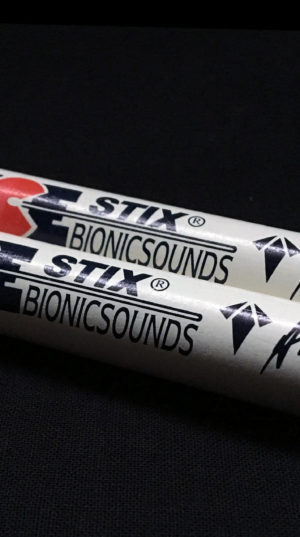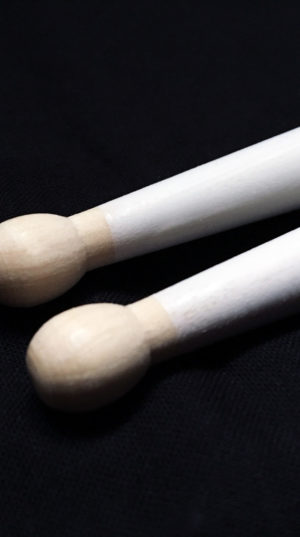Tadaaa! Here they are – my ANDRÉ VARD SIGNATURE ICE-STIX, perfectly built and painted in a cool white. I’ll take that as a reason to try to give some advices or a guide about the choice of drum sticks.Buying drumsticks is quite confusing especially for beginners. I also look at what is myth and what is not regarding to the choice of drum sticks or finding the right drum sticks in my view..
If a toothpick is the right drumming tool for you right now, hit it!
If you are looking for advice on the internet on how to choose drum sticks, you will find a lot of information and reports. Many of the information is correct, true and useful. But some stories are total nonsense or should be regarded as relative and not as absolutely! So it’s like always: You’ve read 1000 different reports and got 1000 different opinions. And now decide for yourself!
The conclusion is: Don’t waste your time reading the 1000 guidebooks, because only the extensive testing of the various drumsticks really helps you. And there is no real right or wrong. It all depends on your own feel of playing with the sticks, in the context of the sound you want to create, and depending on the music being played. If you get what you want with two simple toothpicks and feel good about it, then these toothpicks are the right sticks for you.
There are so-called buying consultants on the internet who scoff at the fact that drummers do not care what they are holding in their hands, the main thing is that they could just start drumming. So what? There is nothing wrong with that! If you enjoy starting out with two tree branches, that’s wonderful. Dig in!
Choosing Drum Sticks – Myth 1
It’s a myth that the perfect drumsticks could turn a good drummer into a top drummer. It’s like saying that you just have to sit in a Ferrari and you can drive a racing car as well as Michael Schumacher. You do not have to be a genius to know that’s nonsense.
If you have not learned the necessary playing technique as a drummer from a good drum instructor and much practice, then no stick in the world can make you better or faster. But who has a good playing technique, can outact an untrained drummer even with a knife and a fork.
Otherwise, if you’re serious about drumming, of course then the Drum Sticks will be important to you, and then you should not care if a pair of Drum Sticks is now 5 Euros or 20 Euros.
Again: First and foremost is your own feeling, when you play with the stick. Then you take care of the sound you want to create and the music you drum to.
Part of your own feeling is that the drum stick with its diameter fits as well as possible into your hand. The length of your fingers or phalanges plays the main role, less the thickness of your fingers and not the size of your palm.
Choosing Drum Sticks – Myth 2
We also don’t need drum sticks to translate the music inside of us, as it is often called, because in principle you can play drums with your bare hands, with your head or your ass. Sometimes this is done – for exactly the same reason, and for one of two reasons why it is helpful to use drumsticks: because of the sound and because of the volume. Drumsticks are simply a helpful tool to play drums.
The second reason is that drumsticks give the drummer technical playing possibilities that are not playable with his bare hands, due to the material of the drumsticks and the fact that we are all subject to universal physics. Your hands are made up of organic cells, muscle tissue, water, and so on, except for the bones inside, ie, soft material – drum sticks are mostly made of wood and that is a hard material.
With a hard stick, the kinetic energy generated by a stroke is much easier to use than with a soft hand. Simply said: You have to strike over the pain threshold to get a useful rebound for your bare hand, which is not really recommendable (look at the claws of professional Conga and Bongo players!). The rebound of a drumstick, however, is the most important energy for almost every kind of drumming.
Choosing Drum Sticks – Myth 3
Forget the numbers and letters in the classification of drumsticks as a selection guide. They are only for your guidance within the product series of a particular manufacturer. They are not usable to compare sticks from different manufacturers because there is no standard at all. A drum stick with the number 5A of the company XY is not as long, thick and heavy as a 5A drum stick of the company YZ. Every manufacturer cooks his own soup.
Most of the following definitions are offered in the model name:
7A = a light, thin stick for gentle and sophisticated play such as Jazz.
5A = lightweight, but slightly thicker standard model than 7A for smooth and normal play.
5B = standard stick, related to weight and length, so to speak, the middle of all, for normal strong drumming such as Pop and Rock.
2B = thicker slightly heavier stick for powerful and loud play, such as Rock, Heavy Metal etc.
 In principle, this orientation might be right, and yet it does not help at the same time. Why? What is the use of a heavy drumstick good for heavy metal music when the stick is simply too thick for your hand or your short phalanges, so you don’t have a good feeling with this stick? Exactly: nothing!
In principle, this orientation might be right, and yet it does not help at the same time. Why? What is the use of a heavy drumstick good for heavy metal music when the stick is simply too thick for your hand or your short phalanges, so you don’t have a good feeling with this stick? Exactly: nothing!
If your hand needs a thin 7A stick, but you want to play heavy metal, then you’re playing Heavy Metal with a 7A stick. No problem. First of all, your drums will be amplified by microphones anyway, and secondly, you could offset the missing mass on the stick for a stronger and louder punch by choosing a stick from a different, harder and heavier wood, if necessary to get the sound you want to.
So important is the material of a drum stick. But, I like to repeat: it’s not as important as your feel!
Drum Stick material
Most drumsticks are made of wood, preferably hickory or maple.
Hickory
Drum sticks made of hickory (American hardwood), are the most popular sticks of most drummers. It’s not quite as hard and heavy as oak wood and is therefore suitable as an all-rounder for all sorts of music styles from soft to hard.
Oak
The hard oak wood makes the drum sticks much longer lasting and is especially suitable for all genres where hard and loud drumming is expected.
Maple
Maple drum sticks are much lighter than hickory sticks. In principle, they are particularly suitable for filigree and fast play, such as for fast jazz licks. Since maple wood is not that hard, a Maple stick can break faster, of course.
Metal or carbon
Aluminum drum sticks are extremely durable, but also heavier. Drummers of the metal scene are the ones who are most likely to get used to it. The same applies to drum sticks made of carbon. They are practically unbreakable and very fast in the responsiveness. This has a reason that also brings the most negative side with it that a drum stick can ever have.
Drum stick material and health
Wood is a living, dynamic material. The influence of nature on the grown tree makes the look and sound of the sticks. No stick is exactly like the other. Metal or carbon drumsticks can be produced almost 100% identically and are so hard that they hardly break. But everything else on the drums, which is hit with these sticks, breaks much faster. The drumheads consumed extremely fast, thin cymbals break down quickly and even thick, heavy cymbals are quickly damaged in case of wrong play (a wrong playing technique of cymbals is enormously widespread among all amateur drummers). The then necessary, recurring new purchase of drumheads and cymbals is much more expensive than to buy new drum sticks because they are used up or broken.
And here is the above-mentioned, negative effect of drum sticks made of metal or carbon: If you were using a super slow-motion camera to film the strokes of the sticks, you would see the sticks of wood bend a bit, extremely little bit, of course, while the sticks of metal and Carbon stay totally rigid. Logically, this has an effect on the energy transfer, which comes back from the drumhead to the hand, over the wrist into the forearm, towards the elbow, etc., through the generated impact. Drummers, who now play many hours at a time with these drumsticks or drum with the wrong playing technique, because they play with holding the sticks too tight or not letting them jump free enough will sometimes have dramatic effects on their health. The most common is the so-called tennis elbow, a painful overload on certain tendons. It can also lead to inflammation or muscle fiber tears in the forearm to arthritis in the fingers and wrists. Muscle tension is the least.
Since a lot of amateur drummers or hobby drummers have a faulty playing technique, I strongly advise not to use these rigid drumsticks made of metal or carbon! You harm your health. Even if you don’t notice any negative effects immediately, you will still have problems after a while, and maybe you will not be able to play drums for a long time or even never. Anyway, I prefer a broken stick rather than a broken wrist.
Shape of the tip
The shape of the tip of a drumstick affects the feel and the sound. If you try drum sticks with different tips, you will notice differences in the rebound. There are a number of different forms. As a rule of thumb, the smaller the impact surface or contact surface of the tip, the higher the generated frequency. This does not mean that a hit with a ball tip produces a higher tone than a stroke with an oval tip, but that the sound has more overtones.
Mainly used forms:
Oval: powerful, broad-sounding sound
Acorn: full sound with good control
Drop: strong, dark sound
Ball: fine touch, clear ping on the cymbals
Barrel: strong punch for high volume
Nylon tips are almost always oval in shape and are chosen for durability and sound, which is quite cold and produces a very clear ping. Consider: The abrasion of nylon tips settles in the grooves of the cymbals. That may not be visible to you, but it’s still there.
Weight of the drum sticks
The weight naturally affects the volume. The heavier the louder. Mostly a high weight reduces the speed of your play.
Length of the drum sticks
The length of a drum stick affects the balance and the pivot point. Longer sticks are automatically louder because of the leverage effect. Shorter sticks are faster and easier to control. More important than the total length of the drumsticks is the length of the shoulder, the area after the tip, which is then thicker towards the shaft. If the drumstick has a short shoulder, it is stronger and more stable and harder to play. If the shoulder is long, the stick responds better and has a stronger rebound.
Interim conclusion
All of these components affect the sound of the stick and the feel of the play. The sound of the stick should fit the music style of your project, but as I said, it’s not useful to play a rubbish bolt for your metal band when the feel is bad and you are playing badly.
So, since the feel of the play is ultimately the only really important criterion for choosing your drum sticks, you’ll have to try many sticks until you find your main stick, so to speak.
Nevertheless, you have not bought a single stick for nothing and I’ll tell you why, and clean up with the next myth.
Choosing Drum Sticks – Myth 4
If you play your drums really dynamic as a musical instrument, and abusing not only as pure whipping machine for your aggression, then it can be really interesting to play a completely different drum stick in one hand than in the other hand for musical reasons.
Of course it’s good, if a pair of drumsticks are almost identical in the sound test. Most drummers lightly beat themselves with the stick on the palm of their hand to compare the sound of the pair of sticks. Drum sticks which nearly sounding the same ensure that your play sounds relatively balanced. But the audience usually only can hear this when there it’s an absolute professional audience, plus you’re a top drummer, and the microphones and the P.A. system are of outstanding quality.
In addition, the absolute identical sound is unreachable because the raw material of the drumsticks is wood, an organic, natural, living material with all its strengths and weaknesses, so full of character, just like you and me.
In addition, your left hand never beats exactly like your the right hand. Although drummers train exactly to be as good as possible with both hands. Your complete two halves of the body, however, never are the same for hundred percent. That’s just it. This also causes differences in sound, bringing the absolute consonance (I’m talking about the myth of the 100 percent) of a pair of drum sticks to absurdity.
And for musical reasons, a small differences lead to different dynamics, which can make the whole play more interesting because it gives it more character. So consonance fanatics exaggerate it in my opinion completely.
Special drum sticks like mallets and brooms
On the special drum sticks like Rods, Wands, brushes, brooms, mallets, timbale sticks, combination sticks, etc., I will not go into detail here. All these sticks are designed for different sound effects or music styles for special sound reasons. You will find enough information on the internet. Maybe someday I will write a second part of this blog.

The Drum Sticks of André Vard
Now about which drumsticks I play myself and why.
My ANDRÉ VARD SIGNATURE ICE-STIX are based on the ICE-STIX 3A model.
• Diameter: 14.90 mm
• Length: 411 mm
• Material: hornbeam
The diameter is perfect for my hand size, or better, the length of my fingers, and the length allows me a flexible grip. I can play the stick at the optimum pivot point or hold it a little further down without slipping all the way to the end of the stick, which would be not a good feeling. I chose hornbeam for my signature stick and not the main played hickory. The lighter weight of hornbeam allows me a technically filigree and, if necessary, a faster play. Nevertheless, the stick is not lacking in volume, because I can just hold it a little further back and already the punch is stronger. In addition, the ICE-STIX have a perfect length of the so-called shoulder, which makes the sticks to be true all-rounders
 The ball shape of the tip gives me clarity in the strokes and a fantastic quick rebound, but the balltip is not too small, so it still has enough punch and I can even drum easily crunching Nu Metal with it. So with the ANDRÉ VARD SIGNATURE ICE-STIX I chose the best feel for the best allround sticks I have ever held in my hands. They are painted in a noble white because I am an audiophile and also a visual person. I really like a cool design!
The ball shape of the tip gives me clarity in the strokes and a fantastic quick rebound, but the balltip is not too small, so it still has enough punch and I can even drum easily crunching Nu Metal with it. So with the ANDRÉ VARD SIGNATURE ICE-STIX I chose the best feel for the best allround sticks I have ever held in my hands. They are painted in a noble white because I am an audiophile and also a visual person. I really like a cool design!
In my assortment you can find more models of ICE-STIX, which are used according to the desired sound and the music style of the project.
Crusher 3A: These drumsticks are the same as my Signature Stick, but made of hickory, the harder wood. I use them when I have to play very hard, but also very accurately and quickly.
Crusher 5B: I play this hickory stick with a tip in acorn shape, when it’s really hard and loud to the point, so for tougher rock music, Metal & Co., but I do not have to play too fast. The Crusher Blue Line is super stylish.
Crusher JOKER: The tip shape of this stick is an intermediate of ball and barrel and allows a very filigree game with absolutely precise tones. Made of solid hickory, I can play with it a bit softer rock music.
Bear JOKER: The tip shape is, as you can see from the name, the same as the Crusher model, also the length and the diameter are identical. The Bear series is, however, as already mentioned for my signature model, made of hornbeam. This wood is lighter than hickory and the feel is soft. I can play with these light sticks at a very high speed. It’s said for a reason that ICE-STIX are the fastest drumsticks in the world.
I also play brushes when needed. Learning a good brush technique is a big thing. If you want to master that perfectly, you have to learn to play the drums almost once more. It’s a completely different way to play.
Breaking drumsticks
To conclude, I have been playing ICE-STIX for 10 years now (or so), and of course I’ve already simply used up sticks. But in fact, over the years, I have never ever broken even a single drum stick from ICE-STIX. For me these ICE-STIX are seemingly unbreakable.
Many drummers break their sticks more or less quickly or often. Sometimes it’s the material, because wood is an organic, living substance, and abrasion is in the nature of things. But if I look at the drummer’s playing, then it’s mostly the faulty playing technique why their drum sticks can break.
Anyone who plays nothing but Rimshots and strikes the sticks too far forward on the edge of the snare ring, must not be surprised about bursting grains. Anyone who puts his hi-hat up and then always hits the edge diligently at the wrong angle will eventually break the sticks. And if you raise your cymbals to forehead height and completely horizontally and then hit the edge really nice with the sticks in a 90-degree angle, not only break the sticks but also break the cymbals. If the drumsticks break quickly again and again, it certainly is not due to the material and then I strongly recommend that you show a good drum teacher your play, even if you don’t want to take lessons. An hour will be enough for the drum teacher to analyze your play and tell you what to change in your playing technique. This will relieve your wallet in the future.
av, 23.01.2019
The 2BOX Drumit 5 MKII drum module
I can quote the simple answer from 2BOX myself: “The...
What Difference Does It Make?
“You have to be ready to be nobody to be...
Only Lovers Left Alive
A vampire movie by Jim Jarmusch would not just be...
Garageband and Midi-Export
One of Garageband’s major weaknesses is its inability to export...
Transfer Garageband songs from iPad or iPhone to Mac and continue editing
Whoever composes songs on the iPad or iPhone in Garageband...
Novation Launchpad for iPad
The free Novation’s Launchpad for iPad app is designed to...
Novation Launchkey for iPad
Matching the launchpad, there’s a second free app from Novation:...
Repair broken headphones
Who does not know that: A few weeks ago, after...




























Best guide ever! Thanx, Sir!
Thank you! I’m glad if it helps!